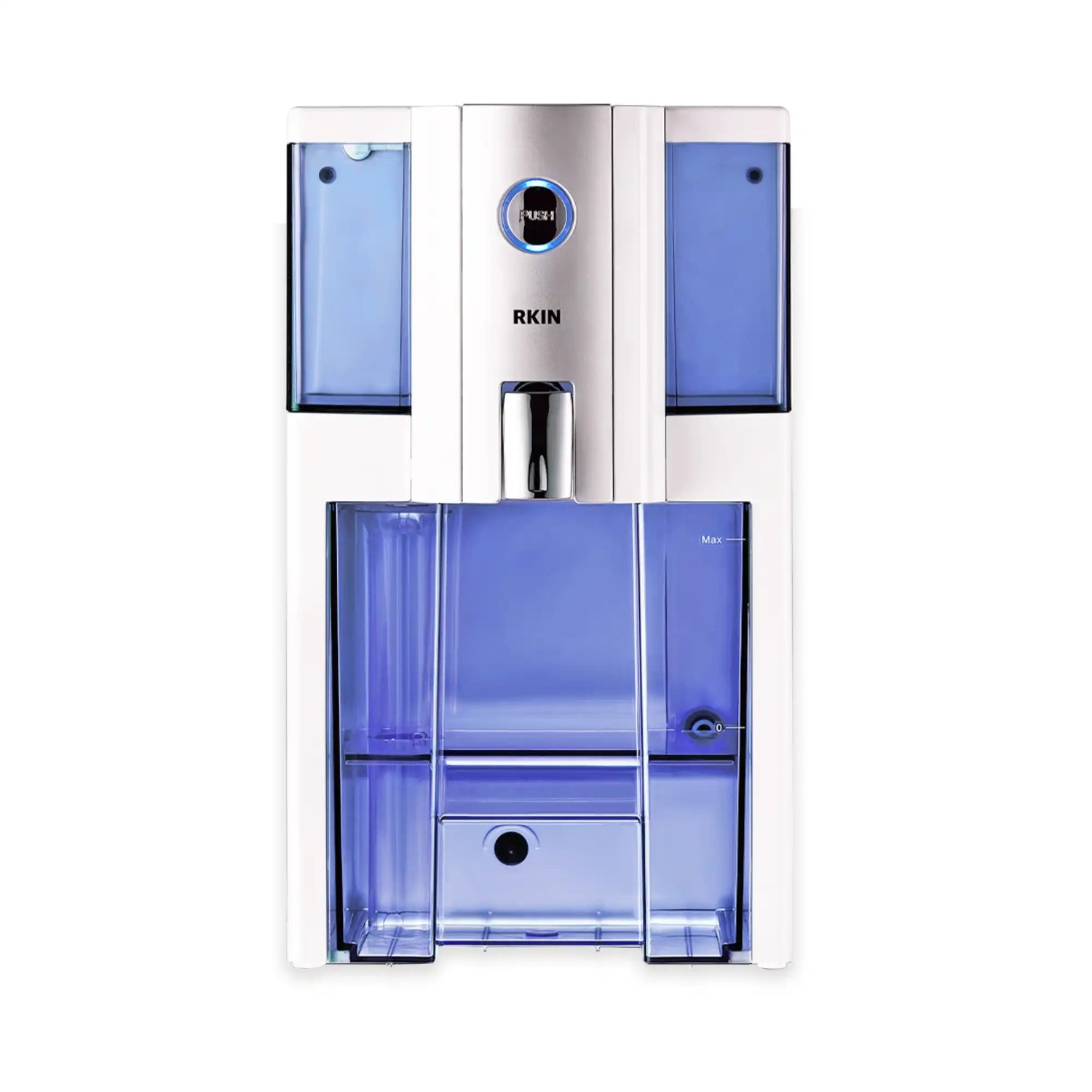
Preocupaciones ocultas sobre el agua: ¿Podría el agua del grifo afectar tu salud hormonal? Explorando contaminantes y soluciones para la pureza.
Compartir
En la búsqueda de una salud óptima y un equilibrio hormonal óptimo, muchos planificamos meticulosamente nuestras dietas, dedicamos horas al ejercicio y priorizamos el sueño. Pero ¿qué ocurre si un elemento crucial, con el que interactuamos a diario, se suele pasar por alto? Nos referimos al agua. Más allá de la simple hidratación, la calidad del agua del grifo podría estar introduciendo una serie de elementos invisibles en el cuerpo, desde el cloro utilizado para la desinfección hasta una mezcla de subproductos y otros contaminantes. Esto plantea preguntas para muchos: ¿podrían los contaminantes del agua del grifo afectar la testosterona o el bienestar general?
La ciencia que analiza cómo cada sustancia presente en el agua impacta directamente en sistemas complejos como la producción de testosterona aún está en desarrollo. Sin embargo, para quienes se preocupan por su salud y quienes buscan un mayor bienestar, el principio de reducir la exposición a sustancias químicas para el equilibrio hormonal es fundamental en una estrategia de salud proactiva. Analicemos los contaminantes comunes del agua y exploremos cómo garantizar la pureza del agua con un filtro de agua para toda la casa para la salud hormonal puede ser un paso fundamental hacia una vida más saludable.
Cloro y sus subproductos (SPD): el arma de doble filo de la desinfección
El cloro es fundamental en el tratamiento del agua potable, eliminando eficazmente bacterias y virus dañinos, lo que hace que el agua del grifo sea segura para beber desde un punto de vista microbiológico. Es una medida crucial para la salud pública, y quienes buscan reducir sus subproductos suelen buscar los beneficios de la eliminación del cloro .

Sin embargo, cuando el cloro reacciona con materia orgánica natural presente (como hojas en descomposición y material vegetal) en el agua, forma un grupo de sustancias químicas denominadas subproductos de desinfección, abreviados como DBP.
Tipos comunes de DBP
- Trihalometanos (THM): algunos ejemplos son el cloroformo, el bromodiclorometano (BDCM) y el bromoformo.
- Ácidos haloacéticos (AHA): como el ácido dicloroacético (DCA) y el ácido tricloroacético (TCA).
Preocupaciones de salud y vías de exposición al DBP
La investigación científica ha identificado más de 700 subproductos de desinfección (SPD) diferentes, y su presencia en el agua tratada es generalizada. Las preocupaciones generales de salud asociadas con la exposición prolongada a ciertos SPD incluyen un mayor riesgo de ciertos tipos de cáncer. Estudios en animales también han indicado que algunos SPD, como el DCA y el TCA, pueden afectar el sistema reproductivo. Si bien la vinculación directa de estos hallazgos con los niveles de testosterona humana a partir de exposiciones domésticas típicas es un área aún en investigación, comprender cómo filtrar los SPD del agua es una preocupación válida.
Estamos expuestos a los DBP no solo a través del agua potable, sino también a través de:
- Inhalación: El vapor de una ducha caliente puede liberar DBP volátiles.
- Absorción dérmica: El contacto con la piel durante el baño o la ducha provoca la absorción de DBP . Para algunos DBP volátiles, como el cloroformo, esta puede ser una vía de exposición importante.

Compuestos orgánicos volátiles (COV): intrusos invisibles en el agua
Los compuestos orgánicos volátiles (COV) son una amplia clase de sustancias químicas que se evaporan fácilmente a temperatura ambiente. Su impacto en el sistema endocrino de los COV es un área de investigación en crecimiento.
Fuentes de COV en el agua
- Disolventes industriales y agentes de limpieza
- Subproductos de los procesos de fabricación
- Pesticidas y herbicidas
- Algunos DBP (como el cloroformo) también pueden clasificarse como COV.
Los COV pueden llegar a fuentes de aguas subterráneas y superficiales y, posteriormente, a nuestro agua del grifo.
Por qué los COV son un problema de salud
Los problemas de salud generales derivados de la exposición a COV varían según la sustancia química específica y el nivel de exposición, pero pueden incluir irritación, efectos neurológicos y un mayor riesgo de ciertos tipos de cáncer. Es crucial para nuestra audiencia que algunos COV también son disruptores endocrinos sospechosos o conocidos, lo que significa que pueden interferir con los sistemas hormonales del cuerpo. Reducirlos es clave para quienes buscan el mejor filtro de agua para su salud general .
Plomo y otros contaminantes: riesgos conocidos en el agua del grifo
Además de los DBP y los COV, otros contaminantes también pueden comprometer la calidad del agua, y es importante estar atento a las señales de mala calidad del agua que afectan la salud .
- Plomo: Este metal pesado suele entrar en el agua potable a través de la corrosión de tuberías y accesorios de plomería antiguos. Los efectos del plomo en el agua sobre la salud están bien documentados, especialmente en niños, y afectan el desarrollo neurológico y la función cognitiva. En los adultos, la exposición crónica al plomo puede contribuir a problemas cardiovasculares y renales.
- Quistes y partículas: Los quistes microscópicos, como los de Giardia y Cryptosporidium, pueden causar enfermedades gastrointestinales. Los sedimentos y otras partículas pueden afectar la claridad del agua y transportar otros contaminantes.
¿Podrían estos contaminantes del agua afectar su salud hormonal?
Muchas personas, especialmente aquellas interesadas en el biohacking o en optimizar su rendimiento físico y mental, se centran en mantener niveles hormonales saludables, incluyendo la testosterona. Las estrategias para optimizar la testosterona suelen implicar un enfoque holístico, y la calidad del agua puede ser parte de ello. Por lo tanto, surge la pregunta: ¿pueden influir los contaminantes del agua del grifo?
Si bien actualmente no existen estudios directos y concluyentes en humanos que demuestren que los niveles típicos de subproductos de la ducha reducen específicamente la testosterona , el principio más amplio de minimizar la exposición del cuerpo a una amplia gama de sustancias químicas es una estrategia de salud sólida. He aquí por qué:
- Reducción de la carga tóxica general: Tu cuerpo trabaja constantemente para desintoxicarse y eliminar sustancias extrañas. Cuantos menos químicos tenga que procesar del agua, el aire y los alimentos, más recursos tendrá para un funcionamiento óptimo, incluyendo el mantenimiento del equilibrio hormonal.
- Posibles disruptores endocrinos: Algunos COV, pesticidas e incluso ciertos metales pesados presentes en el agua se consideran sustancias químicas potencialmente disruptoras endocrinas (EDC). Estas sustancias pueden imitar, bloquear o interferir de alguna manera con las hormonas naturales del cuerpo. Reducir la exposición a todos los posibles EDC es un objetivo común para quienes buscan cuidar la salud hormonal.
- Favorece la salud celular: El agua pura es esencial para todas las funciones corporales. Al proporcionar a tus células agua más limpia, libre de diversos contaminantes, contribuyes a la salud celular general, que es la base de un sistema endocrino que funciona correctamente.
En esencia, mientras esperamos investigaciones más específicas sobre el efecto preciso de cada contaminante individual sobre la testosterona, tomar medidas para garantizar la pureza de su consumo diario de agua filtrando los químicos del agua de la ducha puede verse como una medida proactiva para apoyar el equilibrio natural de su cuerpo y reducir factores estresantes innecesarios.
Filtración para toda la casa: su primera línea de defensa para un agua más pura
Si le preocupa la posible mezcla de contaminantes en el agua del grifo, un sistema de filtración de agua para toda la casa ofrece una solución integral. Los beneficios de la filtración para toda la casa son numerosos, como se detalla en " La guía definitiva de sistemas de filtración de agua para toda la casa ". A diferencia de los filtros de punto de uso (como los filtros de jarra o los accesorios para grifos) que solo tratan el agua de un solo grifo, un sistema para toda la casa se instala en la toma principal de agua, lo que garantiza que toda el agua que entra en su hogar (para beber, cocinar, ducharse, bañarse y lavar la ropa) esté filtrada.

Esto significa que reduce su exposición a contaminantes no solo del agua que bebe, sino también de la inhalación y la absorción cutánea durante las duchas y los baños, que, como hemos visto, pueden ser vías importantes para ciertas sustancias químicas como los subproductos de desinfección (SPD) y los compuestos orgánicos volátiles (COV). RKIN se especializa en proporcionar sistemas robustos de filtración para toda la casa, diseñados para abordar una amplia gama de problemas comunes relacionados con el agua.
Enfoque en las soluciones RKIN para la pureza integral del agua
RKIN ofrece sistemas de filtración avanzados diseñados para proporcionar a toda su casa agua más limpia y segura, abordando problemas que van desde el cloro y sus subproductos hasta los COV y el plomo.
El sistema de filtrado de agua para toda la casa RKIN: su escudo contra el cloro, los subproductos de desinfección y más

Este sistema de múltiples etapas es una fuente inagotable de mejora en la calidad general del agua.
- Cómo funciona: Generalmente combina un prefiltro de sedimentos para eliminar partículas más grandes, un filtro de medios KDF para abordar el cloro, la cloramina y ciertos metales pesados, y un filtro de carbón activado de alto grado.
-
Contaminantes clave abordados:
- Cloro y cloramina: Reduce eficazmente estos desinfectantes, lo que no solo mejora el sabor y el olor, sino que también minimiza la formación de nuevos DBP en las tuberías de su hogar.
- DBP existentes: El carbón activado es eficaz para reducir muchos DBP ya presentes en el agua.
- COV, pesticidas, herbicidas: la filtración de carbón de alta calidad reduce significativamente estos químicos orgánicos.
- Metales pesados: los medios KDF ayudan a reducir el plomo, el mercurio y otros metales pesados.
- Beneficios: Disfrute de agua con mejor sabor y aroma en toda su casa, reduzca la exposición de su familia a un amplio espectro de productos químicos y obtenga tranquilidad sobre el agua que usa todos los días.
Obtenga más información y purifique el agua de su hogar con el sistema para toda la casa RKIN
RKIN OP1L: Protección certificada contra plomo, quistes y COV

Para aquellos con inquietudes específicas sobre el plomo, los quistes microbianos o que desean una capa adicional de defensa química, el RKIN OP1L ofrece protección específica y certificada.
- Cómo funciona: Este sistema emplea tecnología de filtración avanzada diseñada específicamente para la eliminación de alta eficacia de contaminantes difíciles.
-
Contaminantes clave abordados:
- Plomo: Certificado para la reducción de plomo , protegiendo a su familia de esta conocida neurotoxina.
- Quistes: Elimina eficazmente Giardia, Cryptosporidium y otros quistes dañinos.
- COV: Cabe destacar que el sistema OP1L (en concreto, su cartucho RKIN CF1L) también cuenta con la certificación IAPMO para la reducción de diversos compuestos orgánicos volátiles (COV) según la norma NSF/ANSI 53, lo que ofrece una filtración química robusta. Esto lo convierte en una excelente opción para quienes se preocupan por los disolventes industriales, los subproductos de desinfección (SPD) como el cloroformo y otros productos químicos orgánicos sintéticos.
- Beneficios: Proporciona protección específica contra algunos de los peligros más graves transmitidos por el agua, a la vez que reduce significativamente una amplia gama de contaminantes químicos. Ideal para hogares con tuberías antiguas, familias con niños pequeños o cualquier persona que busque una eliminación de COV de primera calidad.
Descubra la protección certificada contra PFAS, plomo, quistes y COV con el RKIN OP1L
Creando un ambiente doméstico más saludable: la conexión con el agua
Controlar la calidad del agua de su hogar es un paso fundamental para crear un entorno de vida más saludable. Al reducir la carga diaria de cloro, subproductos de desinfección, COV, plomo y otros contaminantes potenciales, no solo obtiene agua de mejor calidad, sino que también proporciona un apoyo fundamental para el bienestar general de su cuerpo y su capacidad natural para mantener el equilibrio, incluyendo la salud hormonal.
Tanto si es nuevo en el tratamiento de agua como si está optimizando su salud con biohacking, comprender la composición del agua y cómo abordarla le permitirá tomar decisiones informadas. Si tiene dudas sobre la calidad del agua o sobre qué sistema es el más adecuado para usted, puede programar una consulta con un especialista en agua de RKIN .
Conclusión: Invierte en tu agua, invierte en tu salud
Si bien la relación científica directa entre los subproductos de la ducha y los niveles de testosterona humana requiere más investigación, las preocupaciones más amplias sobre diversos contaminantes en el agua del grifo y su posible impacto en la salud general, incluida la función endocrina, son válidas. Mejorar la pureza del agua es una medida proactiva y tangible que puede tomar.
Los sistemas de filtración de agua para toda la casa de RKIN ofrecen soluciones robustas y confiables para reducir significativamente su exposición a una amplia gama de estos contaminantes, garantizando que cada grifo de su hogar proporcione agua más limpia y segura. Es una inversión en su hogar, su salud y su tranquilidad.
¿Qué medidas está tomando actualmente para garantizar la calidad del agua de su hogar y cuáles son sus mayores preocupaciones en cuanto a los contaminantes del agua y su salud? ¡Comparta su opinión en los comentarios!
Preguntas frecuentes (FAQ)
1. P: ¿Puede un filtro de agua para toda la casa aumentar directamente mis niveles de testosterona?
R: Si bien no existe evidencia científica directa que demuestre que filtrar el agua de la ducha aumente directamente la testosterona, un filtro de agua para toda la casa reduce significativamente la exposición del cuerpo a una amplia gama de contaminantes como el cloro, los subproductos de desinfección (SPD), los compuestos orgánicos volátiles (COV) y los metales pesados. Algunos de estos son posibles disruptores endocrinos. Al reducir la carga química general del cuerpo, se fomenta su capacidad natural para mantener un funcionamiento y equilibrio óptimos, lo que puede incluir una regulación hormonal saludable. Piense en ello como la creación de un entorno interno más limpio para el desarrollo saludable del cuerpo.
2. P: ¿Qué son los DBP (subproductos de desinfección) y por qué debería preocuparme por ellos?
R: Los subproductos de la desinfección (SPD) son compuestos químicos que se forman cuando desinfectantes como el cloro (utilizado para eliminar microbios dañinos en el agua) reaccionan con la materia orgánica presente de forma natural en el agua. Entre los tipos más comunes se encuentran los trihalometanos (THM) y los ácidos haloacéticos (HAA). La exposición prolongada a ciertos SPD se ha vinculado en algunos estudios con un mayor riesgo de ciertos problemas de salud, incluyendo algunos tipos de cáncer, y estudios en animales han demostrado efectos en el sistema reproductivo de determinados SPD. Reducir la exposición a los SPD es una medida prudente para la salud general.
3. P: ¿Cómo es que la ducha me expone a más contaminantes que sólo beber agua?
R: Durante una ducha caliente, entran en juego dos vías principales de exposición a ciertos contaminantes, además de la ingestión:
- Inhalación: Los productos químicos volátiles, como muchos DBP (por ejemplo, cloroformo, un THM) y COV, pueden transformarse en vapor en el aire caliente y humeante de la ducha, que luego se inhala directamente hacia los pulmones.
- Absorción dérmica: Tu piel, especialmente cuando está cálida y con los poros abiertos, puede absorber los químicos presentes en el agua.
Para algunos compuestos volátiles, la exposición a través de la ducha puede ser igual o incluso mayor que la exposición a través de beber la misma agua.
4. P: ¿Qué contaminantes específicos que podrían afectar la salud hormonal eliminan los filtros para toda la casa RKIN?
R: Los sistemas para toda la casa RKIN están diseñados para reducir un amplio espectro de contaminantes.
- El sistema de filtro de agua para toda la casa RKIN (carbón/KDF) elimina el cloro (un precursor de DBP), muchos DBP existentes, COV, pesticidas, herbicidas y metales pesados.
- El RKIN OP1L está certificado para la eliminación de plomo y quistes y, lo que es más importante, también está certificado para la reducción de muchos COV.
Muchos COV y algunos metales pesados se consideran potenciales disruptores endocrinos, por lo que reducirlos contribuye a un suministro de agua más limpio que puede favorecer el bienestar hormonal general.
5. P: ¿El sistema RKIN OP1L también es adecuado para la reducción química general o solo para plomo y quistes?
R: Si bien el RKIN OP1L es reconocido por su eliminación certificada de plomo y quistes, también es altamente efectivo para la reducción de sustancias químicas en general. Su avanzado medio de filtración (en particular, el cartucho RKIN CF1L) cuenta con la certificación IAPMO para la reducción de una amplia gama de compuestos orgánicos volátiles (COV) según la norma NSF/ANSI 53. Esto significa que combate sustancias químicas nocivas como solventes industriales, algunos pesticidas y ciertos subproductos de desinfección (SPD), lo que lo convierte en una solución integral para un agua más limpia y segura, más allá de las partículas y los metales pesados.
6. P: ¿Cómo puedo saber qué filtro de agua para toda la casa RKIN es adecuado para mi hogar?
R: El mejor sistema depende de sus preocupaciones específicas sobre la calidad del agua y las necesidades de su hogar.
- Si sus principales preocupaciones son el cloro, la reducción química general (COV, pesticidas), el sabor y la mejora del olor, el sistema de filtro de agua para toda la casa RKIN (carbón/KDF) es una excelente opción integral.
- Si tiene problemas conocidos con el plomo, inquietudes sobre quistes microbianos o desea una eliminación de COV de primer nivel junto con esas protecciones, el RKIN OP1L es ideal.
Le recomendamos revisar el informe local de calidad del agua o realizar un análisis si tiene alguna inquietud específica. Nuestro equipo estará encantado de ayudarle a elegir la mejor solución. Puede programar una consulta gratuita con un especialista en agua de RKIN para hablar sobre sus opciones.
7. P: ¿Con qué frecuencia se deben reemplazar los filtros de los sistemas para toda la casa RKIN?
R: La vida útil del filtro varía según el sistema RKIN, el consumo de agua y la calidad del agua que ingresa. Cada página de producto en nuestro sitio web detalla la vida útil estimada del filtro para ese sistema (por ejemplo, el sistema de filtro de agua para toda la casa RKIN suele durar entre 500,000 y 1,000,000 de galones, según el tamaño, o 10 años para el medio filtrante principal, lo que ocurra primero, mientras que el cartucho del OP1L tiene su propio programa de reemplazo: cada 100,000 galones equivale aproximadamente a un año de uso para una familia promedio). El reemplazo regular del filtro es fundamental para mantener un rendimiento óptimo.




